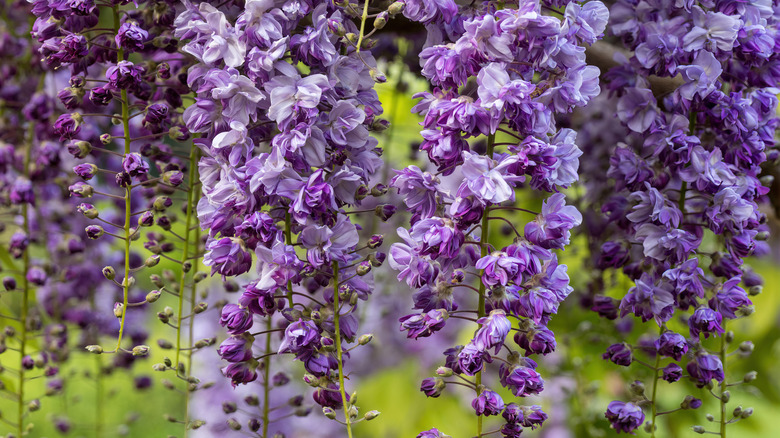The Shrub You Should Be Pruning In November For More Flowers In The Spring
Cascading purple blossoms resembling bunches of grapes are your reward with the right care for a wisteria tree. Undeniably beautiful but easily growing out of control, wisteria (Wisteria sinensis or W. frutescens) is an overly enthusiastic flowering vine or small tree that needs to go under the knife regularly to meet its beauty potential (and to mitigate its energetic growth). It's typically the Asian wisterias (Wisteria sinensis) that get particularly unruly, but even native North American wisterias (W. frutescens) could benefit from a strategic trimming.
To rein in this fast-growing vine, a twice-yearly pruning regimen is wise. A second pruning of your wisteria this November can spur growth on the shoots that hold the buds. Some sources advise against pruning in the fall, but as long as you take extra care not to trim away all of the buds that you want to open into spring flowers, November is prime time to subject your wisteria to the shears — in moderation.
November is not the time to undertake a heavy pruning, however, as that's better left for the spring. If your wisteria is still holding onto leaves, it might also not be fully dormant in November. Plus, any remaining leaves can make it difficult to see where you should prune, so you may want to use caution and wait until closer to winter to prune.
Wisteria pruning in fall is bloom-insurance
Before pruning, it's best to make sure your wisteria is dormant — it will be leafless, but not brittle like a dead branch. Your November schedule may be packed down to the minute, so if holiday obligations don't allow you to squeeze in wisteria trimming, you can also take this on in late winter. Once you're confident that your wisteria is dormant, clean and disinfect your snippers before launching into the task.
Focusing on the lateral branches growing from the main trunk, snip them back to an area holding three to five buds. There's some evidence that limiting branches to three or even two buds encourages the best spring floral performance. Dead or dying branches are also safe to snip at this time.
Additionally, any bits of overgrowth can go in November; the objective is to direct the plant's energy toward flowering rather than churning out excessive vegetation without losing the valuable buds. Beyond the lateral shoots, limit pruning to minor reshaping and removing overcrowded branches. Save further trimming, and any additional pruning, for after the vines have flowered in spring.

